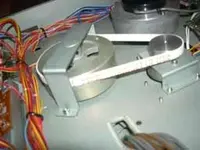T
The Ghost of FM
Banned
I'm seriously happy for you man! Good job!
+1 !

It seemed a bit desperate near the end with all those phantom problems so very glad to see that Cory persevered and got to the bottom of it!

Cheers!

I'm seriously happy for you man! Good job!



It seemed a bit desperate near the end

Some of the wipers in the BUSS MASTER faders had been bent just enough during cleaning to not contact the element anymore.
Another 388 falls into the hands of the rebel forces!!!
Don't be wary of running the machine and playing with it. I truly think it is mild OCD so my way is definitely not necessarily the "right" way.
 (no expectations, really, I've just got calibration on the brain...)
(no expectations, really, I've just got calibration on the brain...)
That's a good question.
The reason is because its a bigger fader...the guts I mean. A channel fader is attenuating the level of one channel so there are two wipers (the springy metal contacts that ride on the actual resistive element); one for the dignal and one for ground. Those BUSS MASTER faders are attenuating 4 channels each...4 group channels. The ODD fader manages groups 1, 3, 5, and 7, and the EVEN fader manages groups 2, 4, 6, and 8. So with 4 channels you have 8 wipers. The wipers don't create a lot of friction, but the wipers are mounted to a nylon carriage which is wider to accommodate all those wipers and THAT is where the higher drag comes from...
(would it be considered OCD cleaning all the plastic nobs individually with a toothbrush?)
-SNIP-
sooooo... do we get to see/hear the part about "and they matched input to output -10db at 1, 10 & 15khz happily ever after..."?(no expectations, really, I've just got calibration on the brain...)
oh, and to get mine going I did have to use a bit of temporary ingenuity that i do hope will not be considered heretical or scandalous by our fine and loyal crowd here... (the belt's on the way!)


 I have these little home-grown passive 5" monitors (I got the cabs at a thrift shop, the woofers from Parts Express on closeout and the tweeters and passive crossovers from an auto install...I had the cabs plotted and put ports in them). I've had them for 15~20 years. They sound pretty good for what they are, but I haven't used them in a long time so I didn't realize how out-of-tune my ears were to them. Playback sounde so-so but then I listened through my Sennheiser HD280 cans and wow...not to shabby lil 388.
I have these little home-grown passive 5" monitors (I got the cabs at a thrift shop, the woofers from Parts Express on closeout and the tweeters and passive crossovers from an auto install...I had the cabs plotted and put ports in them). I've had them for 15~20 years. They sound pretty good for what they are, but I haven't used them in a long time so I didn't realize how out-of-tune my ears were to them. Playback sounde so-so but then I listened through my Sennheiser HD280 cans and wow...not to shabby lil 388. 


 Okay. That was corny, but I'm feeling relieved...I fixed it. Here's what I did:
Okay. That was corny, but I'm feeling relieved...I fixed it. Here's what I did:


1. Q105 which is a transistor that (and I know I'm butchering terminology and maybe even function here so take it with a grain of salt) powers the actual logic switching chip U102. When a L-R assign switch is latched, it connects the emitter of Q105 direct to ground which in turn provides ground to pin 14 of U102 and then it does its thing which switches transistors that route the source of the monitor and stereo busses. So if somehow Q105 was bad and wasn't pulling to ground when a L-R assign switch was pressed, none of the other stuff would do its thing.
2. Suspect #2 is U102 itself. If something was cooked/faulty/just plain wore out inside it wouldn't do its thing regardless of receiving ground continuity.
I started with Q105 because its easier to get replacements of those, less soldering to do the swap, and all around less risky. But, the problem was still there so I bit the bullet and swapped U102. I realize this is a little bit of a hammer-mechanic methodology, but it worked this time. So the 388 is buttoned back up and ready to play today. The above process took about 90 minutes from start to finish so not bad.
 https://homerecording.com/bbs/showthread.php?t=296452) ...did you mean U104 (not U102)? it was the IC chip you switched out that saved the day right? my manual page 3-23 lists U102 as another transistor ("SI.TR.2SA1346" - whats the 'SI' stand for anyway?) and just next to it U104 as the IC ("IC,MC14049B"). on my BUSS B PCB this is confirmed, though they are right next to each other and one could almost read U102 for the IC.
https://homerecording.com/bbs/showthread.php?t=296452) ...did you mean U104 (not U102)? it was the IC chip you switched out that saved the day right? my manual page 3-23 lists U102 as another transistor ("SI.TR.2SA1346" - whats the 'SI' stand for anyway?) and just next to it U104 as the IC ("IC,MC14049B"). on my BUSS B PCB this is confirmed, though they are right next to each other and one could almost read U102 for the IC. )
)did you mean U104 (not U102)?




 ...
...